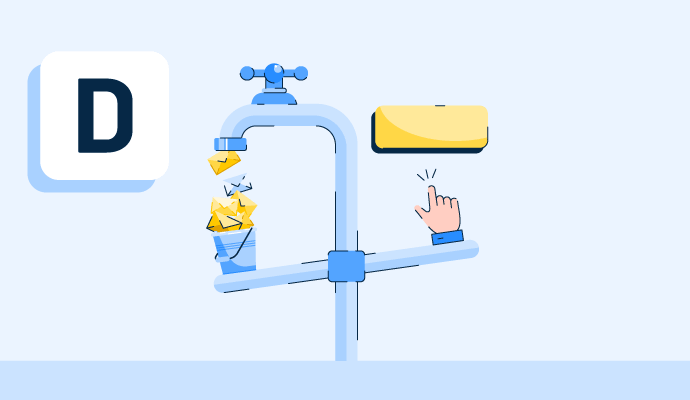What is a drip campaign?
A drip campaign is a marketing strategy that sends automated emails to recipients after they complete a specific action. Marketing teams customize drip emails with the contact’s name and the action they took for a personalized experience.
For example, teams may use drip campaigns when someone signs up for a webinar, downloads an eBook, abandons their cart, or engages with a customer service representative.
Many marketing teams use email marketing software to design, build, and push automated emails out as part of their drip campaign strategy. These tools make it easy for businesses to connect with the right person at the right time.
Types of drip campaigns
Teams can employ drip campaigns to support various marketing strategies and outcomes, from nurturing leads to upselling current customers. Some of the most common types of drip campaigns include:
- Lead nurturing: Leads sometimes need a nudge before purchasing a product or service. A common drip campaign for lead nurturing could comprise a series of educational emails about products and services or a free trial to test a product.
- Welcome: Businesses send welcome drip marketing campaigns to build relationships with new subscribers and contacts quickly. Content for these emails usually consists of something like a thank-you note, an introduction to the business and staff, or a discount code to use for a first purchase.
- Onboarding for new customers: This is a way for businesses to introduce themselves to new customers and share their brand values. Onboarding emails might include steps to get set up or tips for using an unfamiliar product.
- Abandoned cart: Some prospects add items to their cart only to abandon them before completing the checkout process. Brands can lead prospects back to checkout with a drip campaign designed to get interested, but unsure visitors to make a purchase. For instance, emails that offer discount codes could entice the prospect enough that they buy something.
- Upselling recommendations: Recommendation emails are a great way to upsell current clients. Marketing and sales teams can use their client relationship and understanding of client needs to send targeted drip email campaigns that contain additional products and services.
- Unsubscribe: Targeted drip campaigns following an unsubscribe request help businesses understand why individuals leave. For example, some people might unsubscribe because the company sends too many emails, not because they don’t care about the brand. Email campaigns should allow readers to share why they unsubscribed and how they can stay in touch if they choose to do so.
Basic elements of drip campaigns
All drip campaigns include three elements that must occur in a specific order. The key elements are as follows, listed in the order they must occur:
- Trigger: The trigger is the initial event that starts the drip campaign. Teams can determine which events they want to use as triggers. Some examples include subscribing to an email newsletter or abandoning a shopping cart.
- Condition: While triggers kick off drip campaigns, teams must also set predefined conditions for initiating automated emails. One brand may decide to send an automated email immediately after someone subscribes to their blog, but another brand might wait a few hours before sending. These conditions are up to the team running the campaign.
- Action: Drip campaigns encourage the reader to take a defined action. Teams planning these campaigns must consider what that action is so they can measure the effectiveness of the campaign.
Benefits of drip campaigns
Drip campaigns offer many benefits when used strategically. Some key benefits of incorporating drip campaigns into broader email marketing plans include:
- Increased engagement and customer loyalty. Drip campaigns allow brands to connect with prospects and customers at the right time with customized messages. This level of personalization is beneficial for increasing overall engagement and strengthening customer relationships over time.
- More brand awareness. A series of relevant, customized emails keeps brands top of mind regardless of how close the prospect is to making a purchase. These emails are a quick and easy way to connect.
- Lead nurturing opportunities. Drip campaigns can quickly seal a deal or help keep a brand name in mind when the prospect is ready to purchase.
- Fewer abandoned carts. Brands can secure more business by targeting users who abandon carts as part of a drip campaign. This increases revenue and allows the company to find out if a cart has been abandoned solely because of tech.
Drip campaign best practices
Brands should customize drip campaigns to their target audience. In general, there are some best practices brands can consider to achieve the best results from a drip campaign, including:
- Sending timely communications. Nailing the timing of drip campaign emails takes time and practice. Marketers should balance out the amount of information they send and determine appropriate intervals for their drip campaign messages.
- Segmenting email lists. Drip campaign emails work best when the information provided is relevant. Marketing teams can create highly personalized content by segmenting lists into small audiences with shared characteristics or hobbies for more specific messaging.
- Diversifying content, but keeping it relevant. Sending the same content repeatedly isn’t helpful for readers. Instead, teams should experiment with different types of content to determine what’s most beneficial and interesting.
Audience segmentation is key for tailoring marketing campaigns. Read about the best practices to incorporate them into a drip campaign strategy.

Alyssa Towns
Alyssa Towns works in communications and change management and is a freelance writer for G2. She mainly writes SaaS, productivity, and career-adjacent content. In her spare time, Alyssa is either enjoying a new restaurant with her husband, playing with her Bengal cats Yeti and Yowie, adventuring outdoors, or reading a book from her TBR list.





















